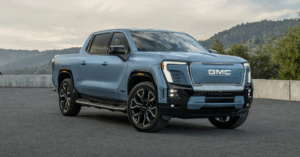
Car shopping used to be simple. You picked gas or diesel, manual or automatic, and called it a day. Now dealership lots are packed with vehicles sporting confusing letter combinations like HEV, PHEV, BEV, and FCEV. These aren’t just marketing gimmicks – they represent real differences in how cars work and what they cost to own.
- HEVs charge themselves while driving through regenerative braking – no wall outlet needed
- PHEVs can run 25-60 miles on pure electricity before switching to hybrid mode
- Smart dealers turn acronym confusion into social media content that educates and sells
HEV: The Self-Charging Hybrid
A Hybrid Electric Vehicle does exactly what the name suggests – it combines electric and gas power. The Toyota Prius pioneered this approach back in the late 1990s, and the concept remains largely unchanged today.
Here’s how it works: You’ve got a regular gas engine paired with an electric motor and a small battery pack. The battery is tiny – about 1 kilowatt-hour – but it doesn’t need to be bigger. The system charges itself every time you brake or coast downhill through something called regenerative braking.
When you’re cruising around town, the electric motor kicks in during acceleration and low-speed driving. The gas engine takes over on highways or when you need extra power. The whole dance happens automatically – you just drive normally while getting 40-50 mpg in most vehicles.
The beauty of HEVs? Zero charging anxiety. You fill up with gas like any regular car, but use way less of it. Perfect for people who want better fuel economy without changing their routine.
PHEV: Electric Driving With a Safety Net
Plug-in Hybrid Electric Vehicles take the hybrid concept and amp it up. These cars have much bigger batteries – typically 10-20 times larger than regular hybrids – that you charge by plugging into a wall outlet or charging station.
This bigger battery changes everything. PHEVs can drive 25-60 miles on electricity alone before the gas engine even thinks about starting up. For many people, this covers their daily commute entirely on electric power.
Once the battery runs low, a PHEV switches to regular hybrid mode. You still get excellent fuel economy, just like an HEV. Think of it as having two cars in one – an electric car for daily driving and a hybrid for longer trips.
The Toyota RAV4 Prime and Ford Escape Plug-in Hybrid are popular examples. Many owners find they rarely use gas for weekly errands but appreciate having it available for weekend road trips.
Here’s the catch: PHEVs cost more upfront than regular hybrids. You also need to remember to plug them in regularly to get the full benefit. Leave it unplugged, and you’re basically driving an overweight, expensive hybrid.
BEV and FCEV: The All-Electric Options
Battery Electric Vehicles represent the full electric experience. No gas tank, no tailpipe, no emissions. Cars like the Tesla Model 3, Chevy Bolt, and Ford Mustang Mach-E run entirely on electricity stored in large battery packs.
Most BEVs can travel 250-400 miles per charge, making them practical for daily use. They’re whisper-quiet, incredibly quick off the line, and cost pennies per mile to operate. The tradeoff? You must plan charging stops for long trips, and installation of a home charger adds to the upfront cost.
Fuel Cell Electric Vehicles use hydrogen instead of batteries to create electricity. The Toyota Mirai and Hyundai Nexo are the main players here. FCEVs refuel as quickly as gas cars and emit only water vapor.
Sounds great, right? There’s one massive problem: hydrogen fueling stations are rare as unicorns outside of California. Unless you live near one of the few dozen stations nationwide, FCEVs remain impractical for most buyers.
Which Technology Fits Your Life?
Choosing between these options depends on your daily routine. If you drive less than 40 miles per day and can charge at home, a PHEV might eliminate most gas station visits while keeping long-distance capability.
For folks who can’t charge at home or regularly drive 100+ miles per day, an HEV delivers great fuel economy without charging hassles. City dwellers with short commutes often love BEVs for their low operating costs and environmental benefits.
FCEVs remain a curiosity unless hydrogen infrastructure expands dramatically. Even then, the technology faces tough competition from improving batteries and expanding charging networks.
Turning Acronym Confusion Into Social Media Gold
Smart dealers see this alphabet soup as a massive opportunity. Confused shoppers need education, and social media is perfect for delivering bite-sized information that builds trust and drives traffic.
Start with simple comparison posts. “HEV vs PHEV: Which Saves More Money?” with real-world examples resonates better than technical specs. Show actual fuel economy screenshots from customer phones or create infographics comparing monthly costs.
Quiz content performs incredibly well across all platforms. “What Type of Electric Vehicle Matches Your Lifestyle?” quizzes generate massive engagement while pre-qualifying potential customers. Include questions about daily driving distance, parking situation, and road trip frequency.
Behind-the-scenes videos showing real customer consultations work wonders for building trust. Film your sales team explaining the difference between charging a PHEV versus filling up an HEV. People love seeing authentic interactions rather than scripted presentations.
Address common myths head-on with “Electric Vehicle Myth Busters” content. Tackle questions like “Do hybrids break down more often?” or “What happens if a PHEV battery dies?” Educational content positions your dealership as a helpful advisor, not just another place trying to make a sale.
User-generated content amplifies your message authentically. Encourage satisfied HEV and PHEV owners to share their experiences – fuel economy improvements, charging routines, or road trip stories. Repost this content to show real-world results from actual customers.
Create seasonal content around these technologies. “Preparing Your PHEV for Winter” or “How HEVs Handle Summer Heat” provides ongoing value while keeping your dealership top-of-mind year-round.
The Road Ahead
These acronyms represent different solutions for different people. HEVs offer worry-free efficiency for traditional drivers. PHEVs provide electric driving with gas backup for the best of both worlds. BEVs deliver pure electric performance for committed early adopters. FCEVs point toward a possible hydrogen future, though that road remains uncertain.
For dealers, this complexity creates opportunity. Shoppers need guidance to make informed decisions. By creating helpful, educational content around these acronyms, you become the trusted partner who helps customers find their perfect match.
The shift toward electrification isn’t just about new technology – it’s about meeting customers where they are in their journey toward cleaner, more efficient transportation. Understanding these acronyms gives you the foundation to succeed in this rapidly changing automotive landscape.
This post may contain affiliate links. Meaning a commission is given should you decide to make a purchase through these links, at no cost to you. All products shown are researched and tested to give an accurate review for you.








